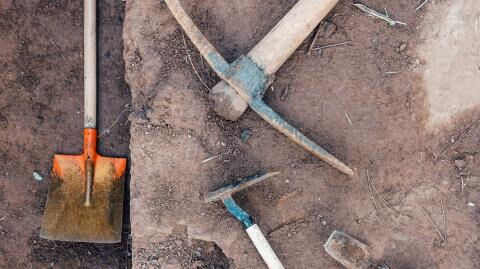Versatile, Artificial Intelligence is used to generate strange images, invent virtual companions and make dead artists sing songs that have nothing to do with their basic register. There's no doubt about it: it's starting a revolution on every level. But while some see it as a threat, others see its development as a genuine scientific opportunity. Researchers at the University of Nebraska-Lincoln, for example, have used it to decipher a parchment that had been unreadable for almost 2,000 years.
Discover our latest podcast
The burnt Herculaneum papyrus
The year is 79. In what is now Italy, a volcano is about to erupt, causing considerable damage. We're talking about Vesuvius, the volcano that wreaked havoc not only in Pompeii, but also (and to a lesser extent) in Stabia and Herculaneum.
In the latter, most of the buildings and inhabitants were destroyed, but a number of artifacts were somehow salvaged. Such is the case of a parchment scroll discovered completely charred in the 18th century by workmen. On the scrollprize.org website, the University of Nebraska-Lincoln explains:
While digging a well, an Italian farm worker discovers a marble pavement. Excavations reveal magnificent statues and frescoes - and hundreds of scrolls. Carbonized and ashen, they are extremely fragile. But the temptation to open them is great: if they were read, they would more than double the literary corpus we possess from antiquity.
Scorched by the eruption of Mount Vesuvius, it barely resembles a papyrus: it's barely possible to make out a shape of paper rolled up on itself. Given its condition, it was thought to be totally illegible from the moment of its discovery, but the rise of imaging technology and Artificial Intelligence has reshuffled the deck and given researchers hope of deciphering it one day.
Tune in with us to hear how #machinelearning is helping researchers unlock the secrets of the Herculaneum papyrus scrolls: https://t.co/9mfYWrm65N#digitalhumanities#DHhttps://t.co/BIQBlni9Io
— NEH (@NEHgov) October 12, 2023
Read more:Archeologists discover a strange 1,000-year-old children's cemetery in Peru
The Vesuvian Challenge: a contest to decipher the famous parchment
To motivate researchers, the University of Nebraska-Lincoln has organized a competition: the Vesuvian Challenge. The aim? To use Artificial Intelligence and computer imaging technology to 'resurrect' the Herculaneum papyrus... without even opening it! A total of $1,000,000 is up for grabs.
And after almost 2000 years, one person has finally managed to decipher a few characters. It's a 21-year-old student by the name of Luke Farritor. Inspired by the discovery of another contestant, Luke focused on the subtle asperities of parchment, visible through X-rays, and developed an algorithm capable of identifying them. The idea was that these asperities represented traces of writing.
Bingo: thanks to his A.I., the young researcher deciphered the word 'ΠΟΡΦΥΡΑϹ', otherwise known as 'Purple'. Following this discovery, Luke Farritor won a prize of $40,000 (around 38,000 euros), a fraction of the jackpot, as the papyrus had only been partially deciphered.
Read more:Researchers reveal real-life Dracula's 500-year-old DNA was hiding a terrifying secret
This article has been translated from Gentside FR.
Source used:
scrollprize.org: First word discovered in unopened Herculaneum scroll by 21yo computer science student















